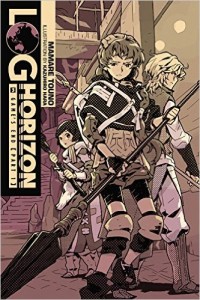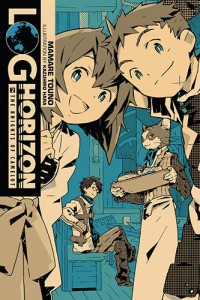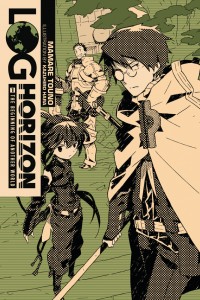By Mamare Touno and Kazuhiro Hara. Released in Japan by Enterbrain. Released in North America by Yen On.
After two reasonably stand-alone novels, Log Horizon now has the first of the ever popular ‘2-volume arc’ books, as seen in SAO, Accel World, and Index has a few soon as well. This does allow for a leisurely pace throughout the book, with only a token cliffhanger at the end. But that’s fine, as this book is doing what Log Horizon does best, which is to showly explain how its world works and how the mechanics of gaming fit into “real” battles. Of course, as Shiroe finds out towards the end of this book, things may not be as simple as all that, particularly when it comes to death in this world.
I’ve said earlier that these books get into game mechanics far too much, and I admit at times I was getting a little bored at all the exposition. At the same time, however, the mechanics are far more important here than they are in SAO, where Kirito may as well just be genuinely using his sword as a sword. Each class has its own strengths and weaknesses, something that takes our newbie heroes (the twins from last book, Serara, and two new kids) the entire volume to really understand. I suspect a few gamers may be a bit frustrated by the “gosh, we need teamwork” lesson being drilled in here, but it’s cute, and serves the purpose of the actual book, which is to develop these five kids into deeper characters, particularly Minori. And we even get a mini-cliffhanger of our own with them, as Rudy seems to have a secret he’s been keeping from everyone.
As for Shiroe and company, instead of dungeon crawling they’re worrying about diplomacy. The other big function of this book is to set up the “people of the land”, which is to say the NPCs – as genuine characters with hopes, dreams, and desires, rather than “I’d love it if you could get that cat out of the tree for me” quest points. They have a history, one that is long and rather dark, as Shiroe finds out. And they have goals that may not mesh well with the adventurers, who they seems to regard as dangerous unknowns. Luckily, we meet Reinesia, the princess of one of the main capitols, who would much rather just lie against a table and be moody all day. I can identify with that. Her interaction with Crusty, who reminds me a lot of Heathcliff from SAO only hopefully without the evil, is one of teh funniest parts of the entire book.
There are also a few suggested romances, though I’m not sure if any of them will actually come off. Isuzu searches her feelings and realizes she likes Rudy as a big dog sort of guy. Akatsuki searches her feelings and comes up empty, though the more experienced reader can tell she’s in love with Shiroe and as yet unaware of it. In any case, romance may take a back seat in the next book, as evil creatures from the black lagoon are coming out from the sea all over the continent. Well, they’re in a game world, you can’t just turn off the bad guys. Log Horizon remains a well thought out series with relatable characters (so many introverts!), and is easy to recommend.



